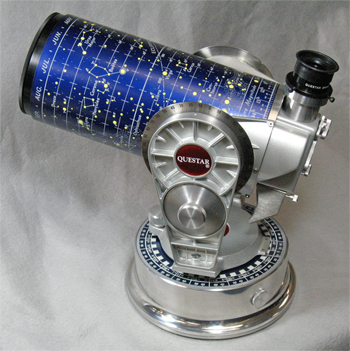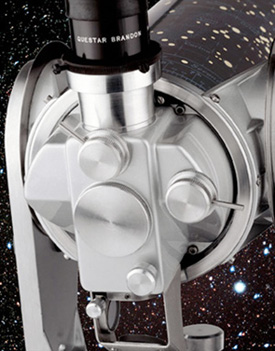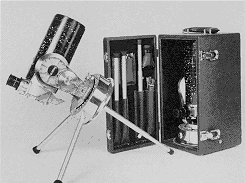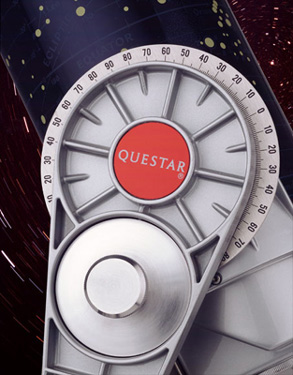Questar Distribution
![]() News
News ![]() Notes & Interesting Articles
Notes & Interesting Articles ![]() Overview
Overview ![]() Pricing
Pricing ![]() Products
Products ![]() Service or Repair
Service or Repair
Questar Telescopes ![]() LD Surveillance Systems
LD Surveillance Systems ![]() LD Microscopes
LD Microscopes ![]() Accessories
Accessories


QUESTAR STANDARD 3-½

The Questar Standard 3-½ has for nearly sixty years been regarded as the finest compact personal telescope in the world. The Questar is an American made family of telescopes and accessories offering unprecedented convenience, manufactured to high industrial levels of perfection and durability. They are made to provide more than a lifetime of rewarding service, and many Questars from the early 1950's remain in service to this day. It has been for many aspiring astronomers the "Holy Grail" of compact telescopes; we hear many who visit our showroom to see a Questar first-hand comment mention they grew up reading the advertisements in "Scientific American" and "Sky & Telescope" - hoping some day they'd own their own.
Right: Questar Standard telescope shown with Questar Brandon 12mm eyepiece attached (135,285 bytes).
Click on the image to see an enlarged view (381,873 bytes)
In addition to the telescope's legendary resolution, flatness of field and startling clear contrast, the Standard has integrated convenient features several which are not available with other telescopes. The Standard Questar telescope has won for the United States and Questar numerous design awards, in fact the Questar 3-½ introduced six patented features to the hobby of astronomy. This telescope has been the model of several attempts to mimic its convenience and performance - yet the Questar remains without peer. These features were conceived by the gifted designer, Lawrence Braymer over more than a decade of research and development in what would go into regular production in 1954 as the "Questar" telescope. A cutaway version of a 1965 Questar telescope was displayed and is retained by the Smithsonian Institution Museum of Technology. The concepts that originated with early production Questar telescopes of 1954 evolved into variants for astronomical uses including the more versatile Duplex 3-½, the larger Seven models, and for terrestrial applications the Field and Birder models.
The design and engineering features made the Questar telescope "user friendly" well before Jobs and Wozniak gave the world the "Macintosh" computer; if Macintosh is the computer for the rest of us, then a good case can be made that the Questar is "the telescope for the rest of us".

Left: Questar Control Box (showing from top to bottom): 1. Questar Brandon Eyepiece in Diopter Adjuster - to focus Finder (with two locking set screws), 2. Barlow Control lever - doubles the magnification when rotated into place (clockwise from 10 to 12 o'clock), 3. Finder or Telescope View selector knob (rotate clockwise from 12 to 3 o'clock into "Finder" position or reverse for "Telescope" view), 4. Axial Port - accepts options including Camera Coupling Set or Image Erecting Prism, 5. Focus Control Knob - jewel smooth, 6. Solar Filter for Finder Mirror (knob below and left of Focus knob) dialed clockwise to store Filter. The Dew Shield/Lens Shade with functional Star Chart is visible just ahead of the Control Box.
Click on image to see enlarged view (232,764 bytes).
The Questar Standard telescope incorporates the Questar Control Box which is engineered and refined to provide reliable convenience and safety features. This housing at the rear of the telescope provides two viewing or imaging ports (at top or axial), with control levers and linkages providing quick flick knob selection. This arrangement provides three magnification (power) changes per eyepiece:
-
1. Internal Finder of 100mm EFL. Magnification = 100 divided by focal length of eyepiece
2. Low Magnification at Prime Focus. Magnification = 1280 divided by focal length of eyepiece
3. High Magnification. Provides about 2X magnification when observing through the telescope; not use able with the Finder.
So, for example one could use the 24mm Brandon eyepiece at 4X with the Finder, then select 50X through the telescope, then increase the magnification to 80X or more by dialing in the Barlow*. Observing through the any of the three magnifications can be achieved and changed without the observer ever moving away from the eyepiece!
The provided telescope Barlow is approximately 2X, but we have seen a range over the years of from 1.6 to more than 2X. Company Seven's testing process measures it exactly, and we provide the information to our customers so that they may make better choices of eyepieces.
A focusing eyepiece holder (Diopter Adapter) at the top of the Control Box permits the user to set the diopter adjustment to focus of the Finder for most persons.
Features within the Questar Control Box include a zenith prism diagonal that can be dialed in or out by the selector knob to move the light from either Finder or Telescope View up to the eyepiece. The eyepiece is installed at a right angle to the barrel thereby making the observing of objects overhead more comfortable. To help place the eyepiece at a more comfortable position for the observer, particularly when tracking in a pole aligned mode, the entire optical tube assembly can be rotated within the fork mount by about 30 degrees clockwise to the right or 30 degrees counterclockwise to the left. To rotate the barrel simply grasp the fork mount with one hand to steady the set, then with the other hand grasp the Control Box to rotate the optical tube. The limit at of rotation is mechanical as the eyepiece holder will be restricted at the length of travel the the stainless steel fin atop either fork tine.
The telescope set includes an off-axis glass Solar Filter for the telescope objective (a full aperture filter is an optional upgrade) providing a pleasing orange red Sun with fine details including Sunspots and Faculae. The Control Box incorporates a solar filter for finder lens to facilitate finding and centering the Sun in the field of view of the telescope and to prevent the accidental observing of the Sun through an unfiltered Finder.
The barrel of the telescope is silk screened with a functional Moon Map, while the removable slide on Dew Cap incorporates a functional Star Chart.

The equatorial Fork Mount of the Questar is made of a brushed cast aluminum which is then lacquer painted. Each of both axes has a manual friction drive control, the Right Ascension also having slip clutch permitting manual override of the tracking motor. The mount includes an AC powered synchronous clock drive motor (world wide portable 9 volt drive corrector optional), driven Right Ascension setting circle, and a Declination circle with declination motion variable clutch lock. The drive is smooth enough to provide flawless tracking of celestial objects for visual applications, although the telescope can easily be accessorized to introduce one into most types of film or CCD astrophotography.
Left: Questar Standard telescope shown in Pole Aligned position on it's table top tripod, and at right stored with standard accessories stored in the case (13,309 bytes).

The Questar Standard 3-½ telescope stores into a furnished compact Vinyl Clad Carrying Case (easily "carry on luggage") that has pockets sewn in the liner to accommodate the included table-top tripod legs, an extra eyepiece, the solar filter, and AC adapter cord. There is also a pocket for the optional Powerguide Controller for worldwide 9 volt D.C. battery powered operation.
Right: Questar Standard Fork Mount. Close up view of Declination Setting Circle, with knurled Declination/Altitude lock knob (47,717 bytes).
When you wish to use your Questar 3-½ astronomical telescope in the backyard or at a location with no convenient platform to set up the provided table-top tripod, we recommend you consider a third party good quality rigid field tripod. Or for even better convenience, consider our Questar Tristand. The Tristand is refined, compact telescope equatorial platform and pier which places the Questar 3-½ eyepiece at a comfortable 41" height. A taller Astropier is also available. The Astropier and Tristand are suitable for use in latitudes from 26 to 90 degrees, or 4 degrees with the optional Wedge.
For more information about how to work your way through the decision making process of choosing and specifying your Questar 3-½" telescope feel free to contact us, or visit our showroom, or refer to the article in our Questar Notes/Library section "How to Choose a Questar Astronomical Telescope".
For current dimensions and a construction overview of the Questar Standard 3-½ telescope sold by Company Seven download the Questar illustrated two page brochure from Company Seven's Library. Download size is 348,071 bytes (in Acrobat Reader ".pdf" format).
Contents Copyright 1994-2007 Company Seven All Rights Reserved

